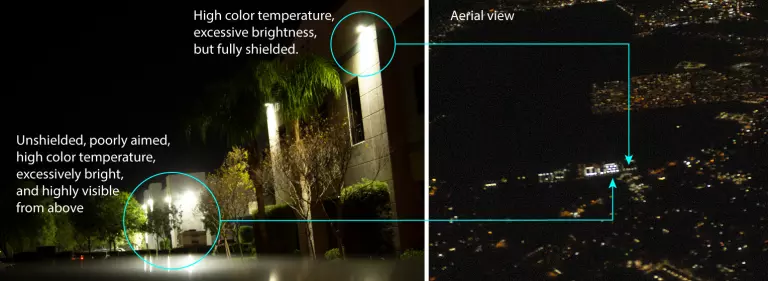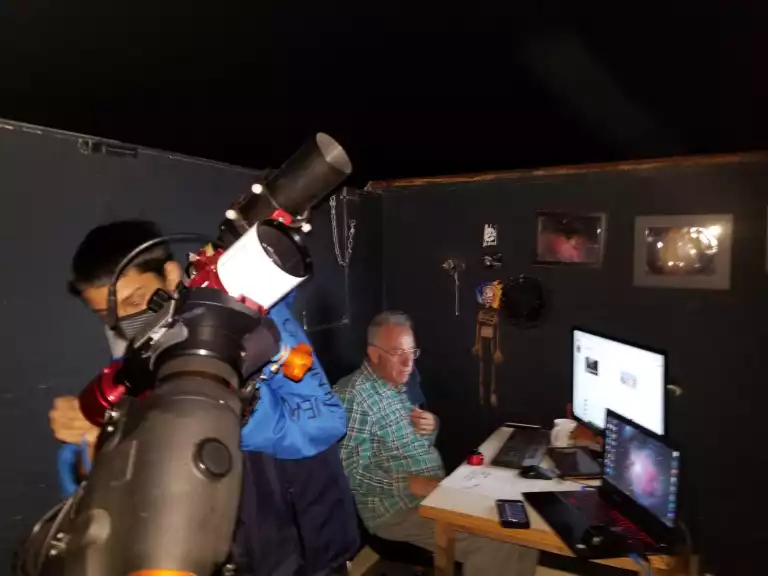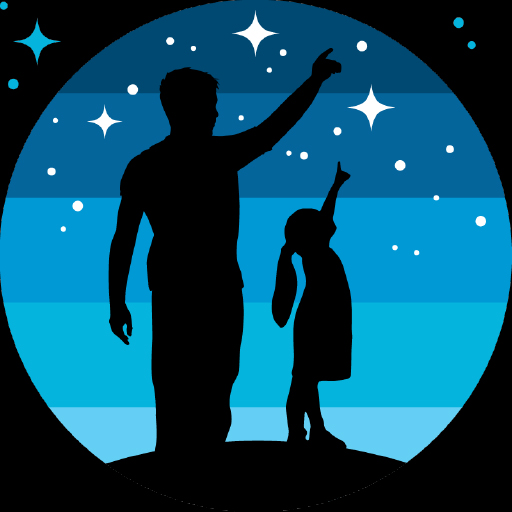
April 2 – 8, 2024
International Dark Sky Week is an annual celebration of our night sky! This year’s events will take place from April 2nd through the 8th. San Diego County residents will be able to enjoy a variety of events and activities to learn more about the dark sky movement, and to experience the beauty of our Milky Way Galaxy for themselves at one of the local star parties. Get all the details in the articles below!
And take the pledge to light responsibly and protect the night!
Get Out at Night!
The most important thing you can do to protect the night is to get out after sunset and learn about it! See some great ideas on the International Dark Sky Week web site, like simply sitting on the back porch with friends while the lights are turned out.
“The Sky Tonight” Planetarium Show and Telescope Viewing with SDAA
Fleet Science Center, Wednesday, April 3 at 7 p.m. and 8:15 p.m.
Celebrate with an outing to the Fleet’s ‘The Sky Tonight’ planetarium show held on the first Wednesday of each month. The April 3 show will be ‘Moons of the Solar System’. Following the planetarium show, members of the San Diego Astronomy Association (SDAA) will have telescopes set up west of the Fleet on The Prado, for free public sky viewing. Learn more and purchase tickets here: https://www.fleetscience.org/events/sky-tonight

Telescope Viewing, “The Sky Tonight” Planetarium Presentation, and Movie “EXO: Are We Alone?”
Palomar College Planetarium, San Marcos, Friday, April 5
1140 West Mission Road, San Marcos, CA 92069
FREE to the public from dusk until 9:30 p.m. – Telescope viewing of the night sky including planets and deep space objects. Astronomers will be in front of the planetarium. This activity MAY CANCEL due to cloudy skies or bad weather.
NOTE: The below ticketed activities are INDOOR events at the Palomar College Planetarium and ARE NOT AFFECTED by bad weather outside.
IMPORTANT: Arrive early, LATE SEATING NOT ALLOWED. Advance, online ticket purchase is recommended, as shows do sell out.
7:00 p.m. – “The Sky Tonight” is a live, narrated planetarium presentation by a college astronomer. Learn about constellations and planets visible in San Diego this time of year. Includes a virtual visit to our Moon, the planets, and more!
8:15 p.m. – Fulldome movie “EXO: Are We Alone?” is a film exploring the mysteries of the Universe and the possibility of extraterrestrial life. This is an astronomically themed, narrated movie presented on the entire planetarium dome overhead.
“Stars at Mission Trails” with SDAA
Kumeyaay Lake, Friday, April 5 at Dusk
Stars at Mission Trails is held on the first Friday of each month, weather permitting.Join members from the San Diego Astronomy Association at the far end of the Kumeyaay Lake Campground’s Day Use Parking Lot to view the nighttime sky through telescopes. Rain or cloudy skies will cancel event. Viewing begins around dusk.
Location: Kumeyaay Lake Campground Day Use Parking Lot, 2 FAther Junipero Serra Trail, San Diego CA 92119 (map).
“Exploring the Universe”

Speaker and Distant Galaxy Viewing
Borrego Springs, Saturday, April 6 at 8:30 p.m.
Astronomy and Viewing: Far Distant Galaxies takes place Saturday, April 6 from 8:30 p.m. – 10:30 p.m. In the springtime, the Milky Way, our home galaxy is no longer visible. While we miss its beauty, the springtime sky is chock full of distant galaxies millions of light years away! This event will explore some of these most distant “island universes.” Speaker: Dr. Randolph Baron, Astronomer & Anza-Borrego Desert Natural History Association (ABDNHA) member.
PAID EVENT: Non-member of ABDNHA $12, Member $10, Volunteer $8
Register in advance at www.abdnha.org as space is limited. Call 760-767-3098 for more information.
See the events calendar at https://www.abdnha.org/calendar1.htm for more ABDNHA activities.
Pre-Solar Eclipse ‘Safe Viewing Tips’ and Sunspot Viewing Event in Valley Center
Valley Center County Library, Saturday
April 6 from 10:30 a.m. – 12:00 p.m.
Dark Skies Valley Center and the Valley Center County Library will host a pre-solar eclipse event, open to the public. The theme of this event is: “How to Safely View a Solar Eclipse”. The solar eclipse will occur on Monday April 8th so be prepared!
The library will be distributing free solar viewing safety glasses. Dark Skies Valley Center will provide solar telescopes and solar filtered binoculars for safe solar viewing by all attendees. Hopefully everyone will be able to safely see sunspots! The sun is expected to be its most active between January and October 2024. There are currently 127 sunspots visible, hopefully we will see many during this event.
Solar Eclipse Viewing Party at the Fleet Science Center
Balboa Park, San Diego, Monday, April 8 at 9:00 a.m.
FREE EVENT on Monday, April 8 from 9:00 a.m. – 12:00 p.m. Experience cosmic wonder with a solar eclipse! Engage in space demos, exciting activities and more. Have your eclipse questions answered by the Fleet’s resident astronomers and eclipse experts from the University of California San Diego, San Diego State University, and the San Diego Astronomy Association.
See details here: https://www.fleetscience.org/events/solar-eclipse-viewing-party
Purchase safe eclipse viewing glasses from the Fleet’s The North Star Science Store (opening at 9:00 a.m.). These specially designed glasses will ensure you can safely witness the eclipse’s awe-inspiring beauty.
With a paid admission to the Fleet (opens at 10:00 a.m.), you can witness solar eclipse totality via a live feed of the solar eclipse in the Fleet’s Heikoff Giant Dome Theater.
Solar Eclipse Viewing Party & Presentation of International Dark Sky Week Proclamation!
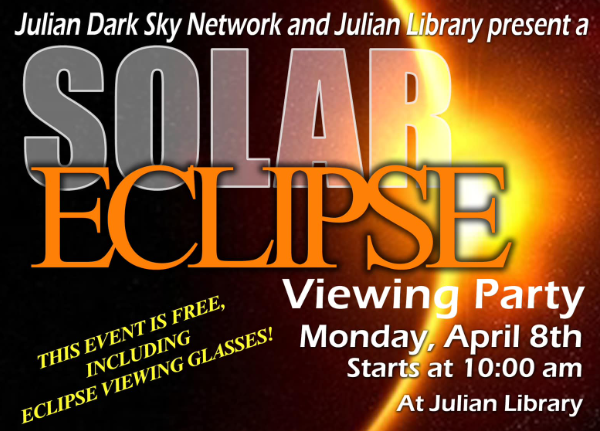
Julian Library, Monday, April 8 at 10:00 a.m.
Members of the Julian Dark Sky Network (JDSN) have planned quite a celebration for International Dark Sky Week at the Julian County Library on Monday, April 8. Activities will begin at 10:00 a.m. as the library opens. View the eclipse event with eclipse glasses and solar telescopes at the Julian County Library. Local high school students will be attending. Joel Anderson’s office of the County of San Diego Board of Supervisors is presenting a proclamation honoring International Dark Sky Week as part of the celebration! What an honor for our DarkSky San Diego County chapter and the community of Julian, the 31st International Dark Sky Community in the world!
Solar Eclipse Viewing at Mission Trails Visitor Center with SDAA
Mission Trails Visitor Center Terrace, San Diego
Monday, April 8 at 9:30 a.m.
One Father Junipero Serra Trail, San Diego CA 92119
Experience the solar eclipse while overlooking the beauty of Mission Trails Regional Park from the terrace at the Visitor Center. Knowledgeable members of the San Diego Astronomy Association (SDAA), park staff, and the Mission Trails Regional Park Foundation will be sure to make this a memorable experience for the entire family.
Visit a Certified Dark Sky Place in San Diego County
San Diego County is home to two certified International Dark Sky Communities and one International Dark Sky Park!
Anza-Borrego Desert State Park – Explore the local desert and camp overnight at Agua Caliente or Vallecito County Park to take in the wonders of the night sky and the soothing hot spring waters. Then head to the northern end of the park to explore Borrego Springs. Learn more about the park from the Anza Borrego Foundation web site.
Borrego Springs – Borrego Springs was designated an International Dark Sky Community in 2009, the second in the world! Come see the wildflowers and experience a truly dark night sky. Visit the Anza-Borrego Desert Natural History Museum for nature displays and information on local activities. Be sure to check out the dark sky display at the Borrego Springs County Library. Members of the Borrego Springs Dark Sky Coalition support dark sky education and outreach in the community.
Julian – Come up for some apple pie and stay for a star-filled night sky! Julian was designated as an International Dark Sky Community in May of 2021. Members of the Julian Dark Sky Network (JDSN) work tirelessly in the community to encourage residents, businesses, and government facilities to light responsibly to maintain their view of the cosmos.
Visit Potrero County Park
View Dark Sky Cosmology Signage, and Camp Under the Stars
Potrero County Park is a great place to camp under the stars and they have some terrific, educational dark sky signage. There’s really good hiking in the park, tent and RV camping sites, a few cabins, and it’s a lovely, scenic drive out to the park. The signs are easily accessible in an open area near some mature oak trees. Thanks goes out to Supervising Park Ranger, Danni Cardiff, who worked to have the signage installed following community interest in night sky programs. Rangers hope to develop a place where folks can give star viewing and talks.
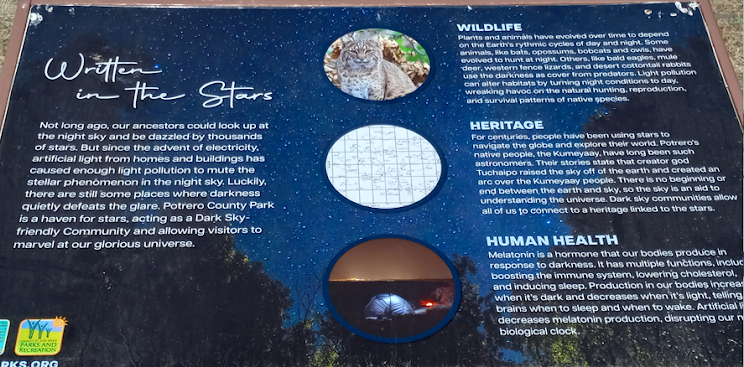
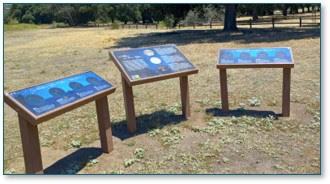
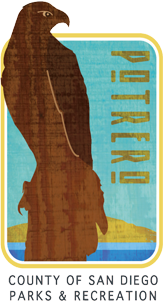
Visit the Dark Skies Exhibit at Santa Ysabel
Santa Ysabel Nature Center
The Santa Ysabel Nature Center has a permanent Dark Skies exhibit with out-of-this-world information on natural darkness, light pollution, and its impact on back country wildlife as well as our ability to view the cosmos. Turn a dial and see what a star-filled sky above the San Diego skyline would look like if light pollution were reduced! Learn more about this award-winning 6,000-square-foot LEED Gold and Zero Net Energy facility and star-gazing hotspot at Santa Ysabel Nature Center (sdparks.org).
Extended hours starting April 1: Monday to Thursday, 10 a.m. – 6 p.m.; Friday – Sunday, 9 a.m. to 7 p.m.
Where: 22135 Highway 79, Santa Ysabel, CA 92070
DIRECTIONS: From CA-78, head NORTH on CA-79 for approximately ¼ mile. Look for the sign/monument near guard rail, and enter through green gates. Drive up the hillside to the nature center building.
IMPORTANT NOTE ON LOCATION: The nature center building is NOT visible from the roadway! It was designed to blend into the environment, so please use the directions and map to help you find your way. GPS navigation may NOT be accurate.
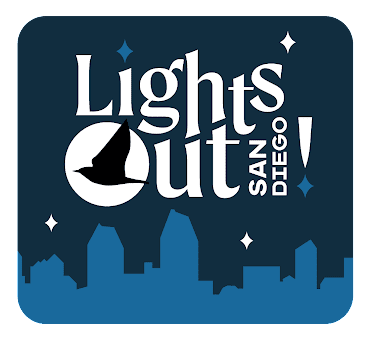
Turn Lights Out to Protect Migrating Birds
Millions of migrating birds are harmed and killed each year from artificial light at night. DarkSky San Diego County and the San Diego Audubon Society are partnering on the “Lights Out, San Diego!” campaign to build awareness about how light pollution impacts migrating birds and other wildlife. You can help provide safe passage for birds traveling to and through San Diego County on the Pacific Flyway by turning off unnecessary outdoor lighting from 11:00 p.m. until 6:00 a.m. during migration season. Take the pledge!
Learn more at Lights Out, San Diego! (sandiegoaudubon.org).
Watch “Losing the Dark”
The “Losing the Dark” is a short planetarium show from DarkSky International introducing light pollution and three simple actions people can take to help mitigate it, available for streaming or download in 15 languages.
‘Save the Sky’ Children’s Animated Audiobook
by Bethany Stahl
A beautifully animated story about light pollution and the night sky, for children.
https://www.youtube.com/watch?v=AfSMD9dpmXE
Online Space Trivia
Can you pass the Kindergarten Astronomy Test? Engage family members and friends to learn and have fun testing your knowledge on planets, constellations, the sun and moon, even the International Space Station (ISS)! Is it true that one of Jupiter’s moons is bigger than Mercury? Take the quiz and find out! https://starwalk.space/en/games
Read Light Pollution Articles by Local DarkSky Advocates
The 2023 International Dark Sky Week celebration in San Diego County featured three essays from DarkSky advocates from San Diego, Julian, and Temecula in the local section of the San Diego Union Tribune print edition and online!
Note, dates reflect the 2023 International Dark Sky Week dates.
Assess Your Home Lighting & Self Certify as Dark Sky Friendly
Commit to protecting the night, every night, by taking a quick survey of your home lighting to see if it’s nature, neighbor, and night sky friendly. Simple changes like shielding or re-aiming a light or switching to a warmer color bulb are often all that’s needed. Proudly display your certificate during International Dark Sky Week!

‘Globe at Night’ Citizen Science Project
Engage your children as citizen-scientists in ‘Globe at Night’ – observe and report night sky brightness from your own backyard!
The Globe at Night program is an international citizen-science campaign to raise public awareness of the impact of light pollution by inviting citizen-scientists to measure their night sky brightness and submit their observations from a computer or smart phone. Light pollution threatens not only our “right to starlight”, but can affect energy consumption, wildlife and health. More than 200,000 measurements have been contributed from people in 180 countries over the last 14 years, making Globe at Night the most successful light pollution awareness campaign to date! Visit Globe at Night to learn more: www.globeatnight.org
Star Party recordings from Curiosity Peak Observatory in Julian
Jupiter-Saturn conjunction, solar star party, light pollution comparison star party, and many more to choose from! https://www.youtube.com/@curiositypeakobservatory2173/streams
“The Night Sky Through Navajo Eyes”
by Ravis Henry
Ravis Henry belongs to the Towering House Clan and was born of the Coyote Pass-Jemez Clan of the Navajo Tribe. He originates from a place called Alamo, New Mexico, but was born, raised, and still resides in Canyon de Chelly/Chinle, Arizona. Currently, Ravis is a Park Ranger with the National Park Service and has been working in the green and grey since 2009, mostly all at Canyon de Chelly National Monument. He works in the field of Interpretation and Education, sharing the stories and history of his people with visitors from around the world. Ravis is a Traditional Knowledge holder and storyteller for his people, and he’s learning the ancient ceremonial ways of the Navajo. He is also an artist/silversmith, creating pieces inspired by the stories of the land and his people. In this presentation, Ravis will introduce the Navajo perspective of the night sky, briefly sharing the stories of how the stars came to be by the acts of the Deities and the Coyote. He will also introduce the Navajo constellations, along with the stories and teachings behind the individual constellations as they are understood by the Navajo People.
https://www.youtube.com/watch?v=EjhTRUVWzSQ
In Conversation with Astronaut Nicole Stott and Tim Russ
Veteran NASA Astronaut Nicole Stott joins a discussion with entertainment industry veteran and visual astronomy enthusiast Tim Russ about what her transformative view of our home planet from space taught her about Earth and our mission to protect it.
https://www.youtube.com/watch?v=b8e8fnWgw-Q
Dark Skies and Light Pollution: An Art-Historical Approach
Contemplation of stars, planets, and galaxies have inspired religions, philosophies, myths, and stories and consideration of visual images of the sky over time provides a basis for protecting the Dark Sky.
Contemplation of stars, planets, and galaxies have inspired religions, philosophies, myths, and stories and consideration of visual images of the sky over time provides a basis for protecting the Dark Sky. https://www.youtube.com/watch?v=3_oXhwL_fxg




